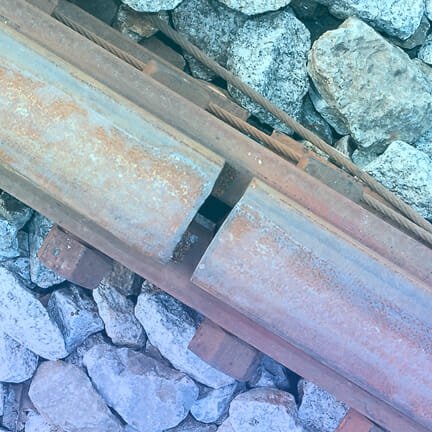
In construction, shrewd builders deploy a technique called expansion joints to allow for unpredictable change. They are commonly found in sidewalks, buildings, roads, railroad tracks, ships, bridges, and other structures.
The reason expansion joints are needed is that sometimes there are vibrations, heat differences, or even movement in things. Before expansion joint gaps were introduced into these structures, solid unmovable objects would often crack under stress or pressure.
Really strong things became fragile.
People and companies need their own set of expansion joints too. In a production setting, allowing for the vibration of unpredictability can help keep things on schedule. You plan for the chaos.
Who doesn’t want to reduce their stress?
What happens in your shop when your lead operator calls in sick, a machine goes down, there is a power failure or some inventory isn’t delivered on the day it was scheduled to arrive?
Does all hell break loose? What type of stress dog-piles on your people or the company? It’s not pretty.
What if you planned your own expansion joint into the process?
Let’s pretend you have an order that has to ship Friday. In your shop when do all the various steps begin to take place so it will ship on that day? Have you mapped out your core processes and determined the timing and steps? Do you wing it and hope for the best?
In today’s business climate, speed is an advantage. There is no waiting. You can’t have a “I’ll do it tomorrow” mentality. Leave that to the yahoo down the street.
A production expansion joint would be to have that Friday order deadline really due for completion in your shop on Thursday. When Friday rolls around that job is already handled and ready to ship. If you are really on top of things, the order shipped out on Thursday…a day early. Wouldn’t this surprise and please your customer?
Does your company operate with the mentality of “get it done early”? If not, how does that happen on a regular basis?
- Orders have to be entered the day they come in. Not tomorrow…today.
- Inventory has to be ordered today too. Get it in by the distributor cutoff.
- Art or digitizing has to happen as soon as possible to get the job approved well before production needs it. Artists tend to have their own internal clock on creativity, and often it isn’t speedy. However, they do work well with deadlines, so you need to set them.
- Screens and digitizing have to be ready one full business day before the job has to start production. The trick is to state on your schedule, or train your staff to figure it out, when the production day start is supposed to happen. If you do this the right way, nobody has to ask.
- Inventory has to be delivered one full day before too. Everything has to be received correctly and counted, boxes have to be labeled with the order information and staged for production. You want to push this so production can grab what they need and stage it by the equipment. Make it easy.
- The job has to be scheduled to production, and the crews given the expectation on when it is needed for completion. It shouldn’t be a guess. Jobs should be lined up in order of completion by each machine with everything the crew needs to complete the job. They don’t go look for anything. Ever.
When is each of the above steps due? Well, frankly that’s up to your production speed and capabilities. What is your average production speed for your equipment (Not the manufacturer’s suggested speed, but your’s in your shop)? What is your turnover time between orders, (from when you finish one job to when you start the next)? How many jobs are already crowded on your dance floor? It’s up to you to determine the landmarked timing for each step. Make it a procedural standard and stick to it.
By including a buffer day on when that job is due you are allowing for that occasional problem that always seems to come up. You know what I’m talking about. You are missing 12 mediums. Nobody ordered the metallic gold ink. A truck crashed into the utility pole down the street so there’s no power until they fix it. There was a big game last night and half your shop has called in “sick”.
These challenges surface, and like a row of dominoes, everything after that is late if you are always working down to the wire.
However, if your mantra is “If you aren’t early you are running late”, then a good chunk of your work is already completed when these problems surface. And they always surface. It’s the expansion joint that keeps your unplanned production earthquake from fracturing your schedule.
Is this easy to do? Frankly no. You can only control so much. Sometimes you have to beg for more time. That is an expansion joint in itself.
For a lot of decorators, this is the busy season already. The schedule is packed and stress levels are already incredibly high. Doing things early just seems like a Jägermeister-induced pipe dream.
Here’s how to get back on track:
- Emphasis on quality. Redoing something because you were in a hurry just slows you down. Make sure your staff double checks everything and is intensely focused on the task at hand. People tend to skip steps when overloaded or rushed. This leads to more failure and a vicious cycle of doom. Slow down. Do one thing right. Then the next. Then the one after that. Prioritize your work and get the biggest challenges handled first.
- Set deadlines for customers to approve artwork or sew outs. “For your order to ship on time we need you to approve this by Tuesday at 12:00 pm”, for example. After you send the approval out, follow up to make sure they have received it and can open the file. Any problems or questions? Set the expectation on the behavior you want from your customer.
- Build standards for your shop as to how people work and the expectations you have for each task. Order entry has to occur the same day the job comes in, for example. If it is before the cutoff, goods have to be ordered that day too. Art has to be completed as soon as they can knock it out…the earlier the better. These three things greatly influence the amount of time production has on the back end to complete their work. When you push things on the front end, your production team will have more time to complete theirs. Typically production gets shafted on valuable time if your front office doesn’t have the hustle mentality. If you are burning screens or digitizing embroidery, the same day the job has to ship, it’s going to be extremely difficult to keep to a production schedule that makes sense. Front load your orders with attention to timing to set up your production crew for success.
- Standardize the work and how you communicate in each department. “For this type of work, we do that.” The more you train your staff on how you want it to be done, the faster they can move. Create independent thinkers. Your trained staff making decisions on their own creates that expansion joint. The “Check With Me” mentality slows you down and is far more rigid, not to mention it is a sign of insecure leadership. Experience, skill and training are what moves the bar upward with people. Create value with your troops by cross training your staff in multiple departments. Sometimes learning “why” that other department handles things a certain way creates some empathy for the burden they bear every day. For example, having Customer Service work in Receiving counting in shipments for a morning or two can create the understanding as to why tracking numbers and packing slips are needed for every order coming in. Communicating this information on your orders is the expansion joint for Receiving to do their work properly.
- Learn to push back or say no. Already insanely busy? Adding another job to the pile isn’t going to help. Does that order really have to ship Friday? Will Tuesday work? Have your staff trained to know your schedule and ask questions. If a job doesn’t make sense, don’t accept it…or still take it and contract it to another decorator. Don’t make matters worse for yourself.
- Bring in extra help when needed. That old adage, “Many hands makes light work”, holds true. Getting some temp labor or summer part time help could be the expansion joint your company needs to get through the chaos. Your full time staff can do all the difficult work, but the new faces can handle unbagging that skid of polos or reclaiming that mountain of dirty screens. The expansion joint here is just an extra set of hands working. Sometimes it’s worth the money Mr. Cheapo.
- Know what your production capacity is and what you have booked. If you use production logs in your shop, you can get an average based on actual historical data on your daily speed. Use this as a benchmark when thinking about what is possible for a standard production day. Anything over this and there needs to be some thought as to how it’s going to get accomplished. Can you bring in more people, work more hours, or contract some of the jobs out? You should be thinking several days if not a week ahead. Constantly map it out.
- Make it easy for your crews to do the right things. Eliminate the need for them to make a choice. Line up the jobs in the order they need to be completed with everything they need to produce the order so nobody has to search for anything. For printers, this is screens, shirts & ink. For embroiders, this is shirts and cones of thread. For heat press jobs, this could be all the names and numbers ready to go. There is zero wasted time looking for something for the order. Eliminate the excuses. Churn and burn.
- To speed up your production, a good way to think about it is to look at your downtime. There are available minutes in your day, you just have to determine how to use them best. Every morning, after break, or after lunch your crews shuffle in to get back going. Start measuring this. Is it five minutes until the first shirt is ready or thirty five? How can you decrease the amount? Think about the downtime during job changeovers. How can your crews take down the old job and set up the new one faster? These two ideas can greatly influence the amount of work produced a day. You have to be looking…
Here’s some homework for your shop: Walk around your building and observe how people work. Think about your workflow. Look for the bottlenecks and friction points in the process.
What causes those? It could be any number of things. Communication, not enough people, not enough training, lack of follow through. Who knows? Dig into the challenge and work out a solution by making it easier for the correct outcome to occur.
Your goal should be that for each core process along the way, whatever is needed is ready and waiting to be worked on at the correct time. Time is your enemy here. Map out your processes and determine, based on your capacity, when things have to happen. Then, define and engineer that result. Create the expansion joints along the way to allow for the common problems that could happen.
It is up to you to set the tone for your shop and to keep things stable by introducing the expansion joints along the way that will allow for unpredictable changes.



